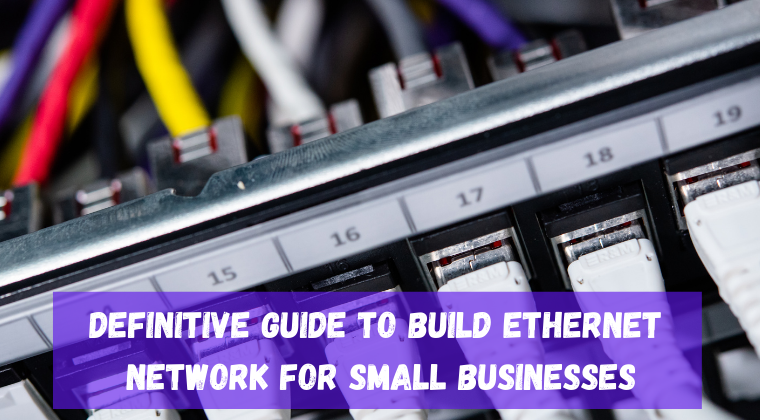Because we live in a digital age, it is now necessary for all businesses to have a data network regardless of size. Cat5e cables, Cat6 cables, and Cat6a cables ethernet network are still the most popular wired network communication options. This post will teach you how to set up a small business network. Please stick with us!
Setting up a network is critical because it connects your company to the internet and allows employees to communicate more quickly and efficiently. You can also exchange files, customers, and other people and businesses across a network. In a word, modern organizations are significantly reliant on IT networks and infrastructure. Your firm may be forced to close if any of them fails or malfunctions.
As a result, establishing a high-quality data network for your company is critical. This post will show you how to succeed in this challenging endeavor.
Figure Out Your Business Needs
You should and must first determine your business demands before investing in cabling and gear. This system element requires cabling, and the prices of Cat5e cables, Cat6 cables, and Cat6a cables vary greatly. So, to spend the right amount on ethernet cables, you must first determine your business demands.
The layout and size of your office are other important considerations when setting up a network. You won’t mind thinking about potential expansions as well. Your employees and devices will expand in tandem with the expansion of your company.
Going wired or wireless
Despite all of the advances in wireless technology, wired networks are still the preferred method of establishing a data network in small and medium-sized enterprises. It’s for various reasons: wired networks are more secure, more stable, have much better data transmission rates than wireless networks, and there are no difficulties with signal loss.
Cat5e, Cat6, and Cat6a cables are the best ethernet cables for wired connectivity; the latter is recommended since they will future-proof your networks for upgrades.
Wireless networks have the problem of being subject to malicious assaults, and if you connect many devices, the performance will suffer.
Server (s)
A powerful server looks after your network in the same way that parents look after their children. Because network servers are designed to support a wide range of devices and applications while also performing various duties, their capacity and size should be adequate.
As a result, you must determine the sort of server you require, the security features and requirements, and the storage capabilities. A well-integrated and competent server will easily support daily operations and your devices, hardware, and software.
Computers
You must select the appropriate computer for your business needs. Purchasing the most recent models is a brilliant idea because it will help future-proof your network for several years.
Determine your budget and the kind of requirements (RAM, ROM, Model, and Storage) that are ideal for you. When it comes to desktops or laptops, the operating system you choose is crucial. Always choose Windows 10 Professional, which is created with companies in mind. Because it was created for residential users, Windows Home Edition is not a good option.
Router/Firewall
As a critical component of networking, firewalls serve a critical role in ensuring data security and integrity, and they are critical to any company’s success. Firewalls check internet traffic entering and exiting your networks, preventing dangerous components such as hackers from entering. Modern-day enterprises place far too much emphasis on data security to be successful; as a result, you must utilize the most robust firewalls available.
When it comes to routers, they create a shared connection by connecting two networks. Furthermore, they connect gadgets to the internet. Routers, brighter than switches, safeguard networks from cyber-attacks and prioritize devices when resources are few.
Switches for network
Choosing the suitable switches for your network is critical since they are the hub around which all connectivity revolves. Switches connect computers to computers, computers to servers, and data must first flow via a switch before passing through computers to the server. Unmanaged switches are popular among businesses because they may be implemented with minimal configuration.
Conclusion:
I’ve gone through the fundamental components of a small company network. It’s perfectly acceptable if you require less or more equipment than what I’ve listed. Don’t worry if all of this sounds perplexing. Your managed service provider (MSP) or network specialist can assist you with the procedure.
When working with small firms, one mistake I’ve observed is a failure to plan for expansion. Last year, I worked with a company that believed that all they required for their office was a single cable modem connection. They purchased equipment based on the idea that their company would not outgrow the speeds offered by its cable provider. They declined a dedicated fiber connection, only to come to regret it six months later when their network became overburdened. Worse yet, their service was shown to be unreliable. They’re in the process of switching to a fiber connection permanently, but it’s been a painful lesson.
Someone once told me that professionals should create a company’s network carefully, just like a qualified electrician would connect a new home. You wouldn’t employ just any guy off the street to wire your house in an unsafe manner. Networks develop and alter throughout time, but the foundation must be laid on solid ground by someone who knows what she’s doing. If you don’t already have an MSP, your ISP may be able to suggest someone who has the skills you’re looking for.

